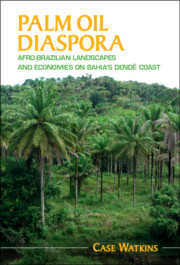Book contents
- Palm Oil Diaspora
- Afro-Latin America
- Palm Oil Diaspora
- Copyright page
- Contents
- Figures
- Tables
- Preface and Acknowledgments
- 1 Assembling an Afro-Brazilian Economy
- 2 African and Atlantic Worlds
- 3 Creolization
- 4 An Afro-Brazilian Landscape
- 5 South Atlantic Exchange
- 6 Landscapes, Religions, Transitions
- 7 Complexity
- Epilogue
- Bibliography
- Index
1 - Assembling an Afro-Brazilian Economy
Published online by Cambridge University Press: 20 May 2021
- Palm Oil Diaspora
- Afro-Latin America
- Palm Oil Diaspora
- Copyright page
- Contents
- Figures
- Tables
- Preface and Acknowledgments
- 1 Assembling an Afro-Brazilian Economy
- 2 African and Atlantic Worlds
- 3 Creolization
- 4 An Afro-Brazilian Landscape
- 5 South Atlantic Exchange
- 6 Landscapes, Religions, Transitions
- 7 Complexity
- Epilogue
- Bibliography
- Index
Summary
This introductory chapter unpacks and integrates the study’s key concepts, theories, and fields to situate the analyses laid out in subsequent chapters. It devotes detailed attention to the inextricable and co-constitutive relationships linking societies, environments, and power. It connects Afro-Brazilian cultures with the myths of racial democracy that helped to shape their emergence in the twentieth century. It discusses concepts of cultural landscapes within economies of transatlantic exchange, and links theories of relational power with Afro-Brazilian resistance and environmental change. It frames the colonial plantation and its monocultures as the ongoing socioecological framework of coloniality, in contrast to the complex biodiverse palm oil landscapes of Northeast Brazil. Along the way, the chapter introduces the real and conceptual places involved in the study, and their interrelations, especially Bahia, the Atlantic World, and the African diaspora. It concludes with a discussion of methods and methodology and an outline of the book’s structure.
Keywords
- Type
- Chapter
- Information
- Palm Oil DiasporaAfro-Brazilian Landscapes and Economies on Bahia's Dendê Coast, pp. 1 - 47Publisher: Cambridge University PressPrint publication year: 2021



